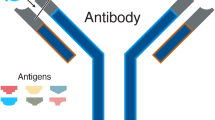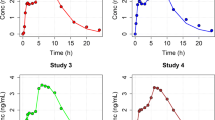Abstract
The concentration EEG effect relationship of heptabarbital was modeled using effect parameters derived from aperiodic EEG analysis. Male Wistar rats (n=10) received an intravenous infusion of heptabarbital at a rate of 6–9 mg/kg per min until burst suppression with isoelectric periods of 5 sec or longer. Arterial blood samples were obtained and EEG was measured continuously until recovery of baseline EEG and subjected to aperiodic analysis for quantification. Two EEG parameters, the amplitudes per second (AMP) and the total number of waves per second (TNW), in five discrete frequency ranges and for two EEG leads were used as descriptors of the drug effect on the brain. The EEG parameters responded both qualitatively and quantitatively different to increasing concentrations of heptabarbital. Monophasic concentration effect curves (decrease) were found for the frequency ranges >2.5 Hz and successfully quantified with a sigmoidal Emax model after collapsing the hysteresis by a nonparametric modeling approach. For the parameter TNW in the 2.5–30 Hz frequency range the value of the pharmacodynamic parameters EC50, E max , and n (¯x± SD) were 78±7 mg/L, 11.4±1.7 waves/sec and 5.0±1.5, respectively. For other discrete frequency ranges, differences in EC50 were observed, indicating differences in sensitivity to the effect of heptabarbital. In the 0.5±2.5 Hz frequency range biphasic concentration effect relationships (increase followed by decrease) were observed. To fully account for the hysteresis in these concentration effect relationships, postulation of two effect compartments was necessary. To characterize these biphasic effect curves two different pharmacodynamic models were evaluated. Model 1 characterized the biphasic concentration effect relationship as the summation of two sigmoidal Emax models, whereas Model 2 assumed the biphasic effect to be the result of only one inhibitory mechanism of action. With Model 1 however realistic parameter estimation was difficult because the maximal increase could not be measured, resulting in high correlations between parameter estimates. This seriously limits the value of Model 1. Model 2 involves besides estimation of the classical pharmacodynamic parameters E max , EC50, and n also estimation of the maximal disinhibition Amax. This model is a new approach to characterize biphasic drug effects and allows, in principle, reliable estimation of all relevant pharmacodynamic parameters.
Similar content being viewed by others

References
N. H. G. Holford and L. B. Sheiner. Understanding the dose-effect relationship: Clinical application of pharmacokinetic-pharmacodynamic models.Clin. Pharmacokin. 6:429–453 (1981).
G. Levy. Pharmacokinetic and pharmacodynamic considerations in therapeutic drug concentration monitoring. In D. D. Breimer and P. Speiser (eds.),Topics in Pharmaceutical Sciences, Elsevier, Amsterdam, The Netherlands, 1983, pp. 43–50.
J. Dingemanse, M. Danhof, and D. D. Breimer. Pharmacokinetic-pharmacodynanic modeling of CNS drug effects: An overview.Pharmacol Ther. 38:1–52 (1988).
J. Dingemanse, D. Thomassen, B. H. Mentink, and M. Danhof. Strategy to assess the role of (inter)active metabolites in pharmacodynamic studies in-vivo: A model study with heptabarbital.J. Pharm. Pharmacol. 40:552–557 (1988).
L. B. Sheiner, D. R. Stanski, S. Vozeh, R. D. Miller, and J. Ham. Simultaneous modeling of pharmacokinetics and pharmacodynamics: Application to d-tubocurarine.Clin, Pharmacol. Ther. 25:358–371 (1979).
N. H. G. Holford and L. B. Sheiner. Pharmacokinetic and pharmacodynamic modeling in vivo.CRC Crit. Rev. Bioeng. 5:273–322 (1981).
W. M. Herrmann and U. Irrgang. An absolute must in clinicopharmacological research: Pharmaco-electroencephalography, its possibilities and limitations.Pharmacopsychiatry 16:134–142 (1983).
W. M. Herrmann and E. Schaerer. Pharmaco-EEG: Computer EEG analysis to describe the projection of drug effects on a functional cerebral level in humans. In F. H. Lopes da Silva, W. Storm van Leeuwen, and A. Rémond (eds.),Handbook of Electroencephalography and Clinical Neurophysiology, Vol. 2, Elsevier, Amsterdam, The Netherlands, 1986, pp. 386–445.
R. J. Hudson, D. R. Stanski, L. J. Saidman, and E. Meathe. A model for studying depth of anesthesia and acute tolerance to thiopental.Anesthesiology 59:301–308 (1983).
D. R. Stanski, R. J. Hudson, T. D. Homer, L. J. Saidman, and E. Meathe. Pharmacodynamic modeling of thiopental anesthesia.J. Pharmacokin. Biopharm. 12:223–240 (1984).
H. Schwilden, J. Schüttler, and H. Stoeckel. Quantitation of the EEG and pharmacodynamic modelling of hypnotic drugs: Etomidate as an example.Eur. J. Anaesthesiol. 2:121–131 (1985).
T. D. Homer and D. R. Stanski. The effect of increasing age on thiopental disposition and anesthetic requirement.Anesthesiology 62:714–724 (1985).
J. R. Arden, F. O. Holley, and D. R. Stanski. Increased sensitivity to etomidate in the elderly: Initial distribution versus altered brain response.Anesthesiology 65:19–27 (1986).
J. Schüttler, H. Schwilden, and H. Stoeckel. Pharmacokinetic-dynamic modeling of diprivan.Anesthesiology 65:A549 (1986).
J. Schüttler, D. R. Stanski, P. F. White, A. J. Trevor, Y. Horai, D. Verotta, and L. B. Sheiner. Pharmacodynamic modeling of the EEG effects of ketamine and its enantiomers in man.J. Pharmacokin. Biopharm. 15:241–253 (1987).
R. P. Koopmans, J. Dingemanse, M. Danhof, G. P. M. Horsten, and C. J. van Boxtel. Pharmacokinetic-pharmacodynamic modelling of midazolam effects on the human central nervous system.Clin. Pharmacol. Ther. 44:14–23 (1988).
D. J. Greenblatt, B. L. Ehrenberg, J. Gunderman, A. Locniskar, J. M. Scavone, J. S. Hramatz, and R. I. Shader. Pharmacokinetic and EEG study of intravenous diazepam, midazolam and placebo.Clin. Pharmacol Ther. 45:356–365 (1989).
T. K. Gregory and D. C. Pettus. An electroencephalographic processing algorithm specifically intended for analysis of cerebral activity.J. Clin. Monit. 2:190–197 (1986).
M. Danhof and G. Levy. Kinetics of drug action in disease states. V. Acute effect of urea infusion on phenobarbital concentrations in rats at onset of loss of righting reflex.J. Pharmacol. Exp. Ther. 232:430–434 (1985).
M. C. Dementrescu. The aperiodic character of the electroencephalogram.Physiologist 18:189 (1975).
J. D. Unadkat, F. Bartha, and L. B. Sheiner. Simultaneous modeling of pharmacokinetics and pharmacodynamics with nonparametric kinetic and dynamic models.Clin. Pharmacol. Ther. 40:86–93 (1986).
L. K. Paalzow, G. H. M. Paalzow, and P. Tfelt-Hansen. Variability in bioavailability: Concentration versus effect. In M. Rowland, L. B. Sheiner, and J. L. Steimer (eds.),Variability in Drug Therapy: Description, Estimation and Control, Raven Press, New York, 1985, pp. 167–185.
W. D. Winters. A review of the continuum of drug induced states of excitation and depression.Prog. Drug. Res. 26:225–258 (1982).
S. C. Harvey. Hypnotics and sedatives. In A. Gilman, L. S. Goodman, T. W. Rall, and F. Marud (eds.),The Pharmacological Basis of Therapeutics, 7th ed., Macmillan, New York, 1985, pp. 339–371.
H. Büch, J. Knabe, W. Buzello, and W. Rummel. Stereospecificity of anaesthetic activity, distribution, inactivation and protein binding of the optical antipodes of two N-methylated barbiturates.J. Pharmacol. Exp. Ther. 175:709–716 (1970).
M. van der Graaff, N. P. E. Vermeulen, R. P. Joeres, and D. D. Breimer. Disposition of hexobarbital enantiomers in the rat.Drug. Metab. Disp. 11:489–493 (1983).
G. Wahlström, H. Büch, and W. Buzello. Unequal anaesthetic potency despite equal brain concentration of hexobarbital antipodes.Acta Pharmacol. Toxicol. 28:493–498 (1970).
T. J. Haley and J. T. Gidley. Pharmacological comparison of R(+), S(−) and racemic secobarbital in mice.Eur. J. Pharmacol. 9:358–361 (1970).
H. Downes, R. S. Perry, R. E. Ostlund, and R. Karler. A study of the excitatory effects of barbiturates.J. Pharmacol. Exp. Ther. 175:692–699 (1970).
W. J. Waddel and R. Baggett. Anesthetic and lethal activity in mice of the stereoisomers of 5-ethyl-5-(l-methylbutyl)barbituric acid (pentobarbital).Arch. Int. Pharmacodyn. 205:40–44 (1972).
L.-Y. Huang and J. L. Barker. Pentobarbital: Stereospecific actions of (+) and (−) isomers revealed on cultured mammalian neurons.Science 207:195–197 (1980).
F. Leeb-Lundberg, A. Snowman, and R. W. Olsen. Barbiturate receptor sites are coupled to benzodiazepine receptors.Proc. Natl. Acad. Sci. U.S. 77:7468–7472 (1980).
G. Wahlström and L. Norberg. A comparative investigation in the rat of the anesthetic effects of the isomers of two barbiturates.Brain Res. 310:261–267 (1984).
M. K. Ticku, S. K. Rastogi, and R. Thyagarajan. Separate site(s) of action of optical isomers of 1-methyl-5-phenyl-5-propylbarbituric acid with opposite pharmacological activities at the GABA receptor complex.Eur. J. Pharmacol. 112:1–9 (1985).
A. M. Allan and R. A. Harris. Anesthetic and convulsant barbiturates alter gammaaminobutyric acid-stimulated chloride flux across brain membranes.J. Pharmacol. Exp. Ther. 238:763–768 (1986).
M. H. H. Chandler, S. R. Scott, and R. Blouin. Age-associated stereoselective alterations in hexobarbital metabolism.Clin. Pharmacol. Ther. 43:436–441 (1988).
U. S. Vasthare, G. L. Irion, C. Carlsson, and R. F. Tuma. Differential effects of anesthetic agents on regional blood flow and central haemodynamic parameters in rats.Drug Devel. Res. 14:59–65 (1988).
A. A. Artu. Dose-related changes in the rate of cerebrospinal fluid formation and resistance to reabsorption of cerebrospinal fluid following administration of thiopental, midazolam and etomidate in dogs.Anesthesiology 69:541–546 (1988).
M. Danhof and G. Levy. Kinetics of drug action in disease states I. Effects of infusion rate on phenobarbital concentrations in serum, brain and cerebrospinal fluid of normal rats at onset of loss of righting reflex in rats.J. Pharmacol. Exp. Ther. 229:44–50 (1984).
N. Dafny. Hypothalamic evoked responses altered by pentobarbital in freely behaving rats.Electroencephalog Clin. Neurophysiol. 36:123–130 (1974).
M. B. MacIver and S. H. Roth. Barbiturate effects on hippocampal excitatory synaptic responses are selective and pathway specific.Can. J. Physiol. Pharmacol. 65:385–394 (1986).
M. Willow and G. A. R. Johnston. Dual action of pentobarbitone on GABA banding: Role of binding site integrity.J. Neurochem. 37:1291–1294 (1981).
R. L. Macdonald and J. F. Barker. Anticonvulsant and anesthetic barbiturates: Different postsynaptic actions in cultured mammalian neurons.Neurology 29:432–447 (1979).
D. W. Schulz and R. L. MacDonald. Barbiturate enhancement of GABA-mediated inhibition and activation of chloride ion conductance: Correlation with anticonvulsant and anesthetic actions.Brain Res. 209:177–188 (1981).
P. E. Keane and K. Biziere. The effects of general anaesthetics on GABAergic synaptic transmission.Life Sci. 41:1437–1448 (1987).
J. A. Richter and J. R. Holtman, Jr. Barbiturates: Their in vivo effects and potential biochemical mechanisms.Prog. Neurobiol. 18:275–319 (1982).
Author information
Authors and Affiliations
Additional information
This study was supported by MEDIGON Grant 900-521-106.
Rights and permissions
About this article
Cite this article
Mandema, J.W., Danhof, M. Pharmacokinetic-pharmacodynamic modeling of the central nervous system effects of heptabarbital using aperiodic EEG analysis. Journal of Pharmacokinetics and Biopharmaceutics 18, 459–481 (1990). https://doi.org/10.1007/BF01061705
Received:
Revised:
Published:
Issue Date:
DOI: https://doi.org/10.1007/BF01061705



